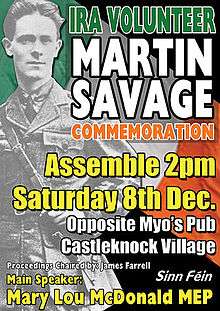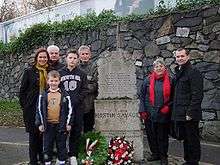Martin Savage
| Martin Savage Irish: Máirtín Sabhaois | |
|---|---|
 | |
| Born |
1898 Ballisodare, County Sligo, Ireland |
| Died |
19 December 1919 Ashtown, County Dublin, Ireland |
| Allegiance | Irish Republican Army, Irish Volunteers |
| Years of service | 1916 – 1919 |
| Rank | Officer |
| Unit | Dublin Brigade |
| Battles/wars | Easter Rising, Irish War of Independence |
Volunteer Martin Savage Irish: Máirtín Sabhaois (1898 – 19 December 1919) was an Officer in the Dublin Brigade of the Irish Republican Army, from Ballisodare, County Sligo.[1] On 19 December 1919 he was killed in a gun battle during an ambush at Ashtown, near the border of County Meath and County Dublin, during the early stages of the Irish War of Independence.
Early life
Savage was born in Streamstown, Ballisodare, County Sligo in 1898. He was the youngest son of Michael Savage, who was known locally as a Fenian activist.[2] After leaving school he worked as an apprentice grocer in Sligo Town before committing himself to the fight for Irish Independence.[3][4][5][6][7][8]
Military action
Savage moved to Dublin in 1915 and joined the Irish Volunteers. As a 17-year-old he took part in the 1916 Easter Rising in Dublin and fought initially in the GPO and later at the Four Courts.[9]He was captured by the British Army and imprisoned in Richmond Barracks. On 30 April 1916 he was deported to Knutsford Detention Barracks in Cheshire, England along with 200 other captured prisoners. Upon his release Savage returned to Dublin and resumed his fight for Irish freedom and became a Lieutenant in the 2nd Battalion of the Dublin Brigade. Within republican circles he was known as a shy, slim built, handsome Sligonian who was a popular and trusted comrade especially amongst the likes of Dan Breen, Seán Treacy and Seán Hogan.[2] [10]
The Ashtown ambush
Planning by Breen
On 19 December 1919, Savage and 10 fellow Volunteers, including Mick McDonnell, Tom Kehoe, Seán Treacy, Seamus Robinson, Seán Hogan, Paddy Daly (Leader), Vincent Byrne, Tom Kilcoyne, Joe Leonard and Dan Breen, met after planning to assassinate the then British Viceroy, Lord Lieutenant of Ireland and Supreme Commander of the British Army in Ireland, Lord John French, as he returned from a private party which he had hosted the previous evening at his country residence in Frenchpark, County Roscommon.[11]
It was not originally planned that Savage was to take an active part in the ambush, however, after a chance meeting with Breen and Hogan, Savage insisted that he join the party. Sean Hogan initially attempted to dissuade the eager young volunteer, but eventually he relented and gave Savage an automatic pistol. The Volunteers' intelligence operative had informed the unit that Lord French would be travelling in the second car of the armed convoy that comprised an outrider and three following cars which would bring Lord French from Ashtown railway station to the Vice-Regal Lodge in Phoenix Park, Dublin.[12]
Events of the day
On the day of the ambush, Savage attended work as usual and slipped away early in the morning to meet with the Volunteers who were gathered at Fleming's Pub in Drumcondra. They departed Drumcondra in small groups to avoid raising suspicion as they cycled through Phibsboro and up the Cabra Road, and then regrouped at Kelly's Public House (now called the Halfway House) in Ashtown. At approximately 11:40 a.m., as the train carrying Lord French pulled into the station, the unit left the pub and took up positions along the crossroads at Ashtown.
The plan was for Martin Savage, Tom Kehoe and Dan Breen to push a hay-cart halfway across the road and then, after the out-rider and the first car had passed, they would push it the rest of the way across the road, thereby completely blocking the path of the remaining vehicles. They had been informed that Lord French was to be in the second car and this car would be attacked with grenades, Mills Bombs and concentrated rifle fire.
As they pushed the hay-cart across the road their plan was almost foiled as a member of the Royal Irish Constabulary (RIC) disturbed them, telling them to move on. One of Volunteers lobbed a grenade at him, although it didn't explode it struck the police officer on the head, knocking him unconscious. The police officer was then dragged from the road and the attack went ahead as planned.[13]
Lord French's car and the gun battle
When the convoy appeared minutes later, each Volunteer fulfilled their role in the operation and attacked the second car forcing it to swerve off the road. However, unknown to the unit, Lord French was travelling in the first car and managed to drive through the blockade. The occupants of the second car, part of Lord French's guard, returned fire. As the fierce gun battle developed the third car arrived on the other side of the cart and began firing with rifles and machine-guns on the now exposed Volunteers.
In the crossfire Dan Breen was shot in the leg and seconds later Savage fell mortally wounded after being hit by a bullet in the neck. He died in the arms of Dan Breen and his last words to Breen were "I'm done, but carry on....". Tom Kehoe and the wounded Dan Breen succeeded in carrying Martin Savage's body from the road and back to Kelly’s Pub while the gunfight continued.[14]
Two RIC men and a driver were also wounded in the gun battle. At this point the British military, including some wounded, began to withdraw from the scene and continued on towards the Phoenix Park. Knowing British reinforcements would be on their way, the IRA unit then dispersed to safe houses in the Dublin area. Dan Breen was helped onto his bike by Paddy Daly who helped him to a safehouse in the Phibsboro' area, where he was attended to by the captain of the Dublin hurling team, Dr J.M. Ryan.
The next morning, the Irish Independent published an article which described the attackers as "assassins" and included other such terms as "criminal folly", "outrage" and "murder." Taking these terms as an insult to their dead comrade, it was decided to attack the paper. On Sunday, at 9pm, between twenty and thirty Volunteers under Peadar Clancy entered the offices of the Independent. They informed the editor of their intentions and began to dismantle and smash the machinery. Despite this action, with the assistance of the other Dublin papers, the Independent was able to appear the next day, and the owners were awarded £16,000 pounds in compensation. According to Breen, neither the Independent, nor any other Dublin paper, referred to the IRA as murderers or assassins again.[15]
Funeral
Savage's body was taken by British military and an inquest was held into his death. The inquest was attended by his brother and his employer William Kirk, who described the dead soldier as "a steady, sober and industrious young man, gentlemanly in manner and extremely courteous."[16]
After the inquest, Savage's body was handed over to his relatives. His remains lay overnight at Broadstone Station before departing for Sligo where it was met at Collooney railway station by a large crowd.[17] His coffin, draped in an Irish Tricolour, was carried over two miles at shoulder height to his family's burial ground. Savage was buried with full military honours in his native Ballisodare, County Sligo.[18]

Dan Breen noted that "the cortege was several miles long, the Parish Priest attended and recited the last prayer, while the RIC, with a chivalry characteristic of them, surrounded the graveyard with guns and bayonets. However, I suppose, this was the best tribute they could have paid to a gallant soldier, even though they did not mean it that way".[18][19]
Legacy of Martin Savage




In 1948, the National Graves Association erected a memorial to Savage close to the site of the ambush at Ashtown Cross. There is an annual commemoration of his death at the site of the ambush.[20][21][22]
There have also been a number of streets and public places named after the Volunteer including Martin Savage Place in County Meath, Martin Savage Road and the home of Kinvara Ards, Martin Savage Park in County Dublin and Martin Savage Terrace near the centre of Sligo Town.[23][24]
The Ashtown Fianna Fáil Cumann, named after Martin Savage, hold an annual commemoration on the Sunday after the anniversary of his death at the Ashtown memorial site. Since 2002, the Sinn Féin Joe McDonnell Cumann hold an annual rally on the anniversary of his death also.
The Coen/Savage (East Sligo) Sinn Féin Cumann also hold a wreath laying ceremony every Easter Sunday morning at Martin Savage's graveside in Ballisodare, Co. Sligo.
References
- ↑ Roger McDonnell
- 1 2 McTernan, John C. (1994). "Patriot sons and daughters". Worthies Of Sligo, Profiles of Eminent Sligonians of Other Days. Sligo: Avena Publications. p. 210. ISBN 0-9520594-3-6.
- ↑ Unknown. "Sinn Féin Easter commemorations". Leitrim Observer. Retrieved 6 April 2006.
- ↑ Wayne Sugg. "Christmas week ambush". An Phoblacht. Retrieved 30 September 2006.
- ↑ Unknown. "Vol Martin Savage". PearseCom. Retrieved 30 September 2006.
- ↑ Roger McDonnell. "1901 Census Search". Leitrim Roscommon. Retrieved 30 September 2006.
- ↑ Anna Ryan. "Old Ballisodare Cemetery, County Sligo". Cemetery Transcription Library. Retrieved 26 July 2001.
- ↑ Des Keenan. "Ireland 1850-1920". Des Keenan. Retrieved 30 September 2006.
- ↑ "Roll of Honour". 1916 proclamation.
- ↑ My Fight For Irish Freedom, Dan Breen, 1989. PB) ISBN 0-947962-33-6 p.85, p.90 - p.95, p.168
- ↑ My Fight For Irish Freedom, Dan Breen, 1989. PB) ISBN 0-947962-33-6
- ↑ "Remembering Martin Savage". An Phoblacht. Retrieved 17 June 2007.
- ↑ Wayne Sugg
- ↑ "No Fear!". TIME Magazine. 9 May 1932. Retrieved 17 June 2007.
- ↑ Dan Breen, My Fight for Irish Freedom, [Talbot Press, 1924], 1989, ISBN 978-0-947962-33-3.
- ↑ McTernan, John C. (1994). "Patriot sons and daughters". Worthies Of Sligo, Profiles of Eminent Sligonians of Other Days. Sligo: Avena Publications. p. 211. ISBN 0-9520594-3-6.
- ↑ My Fight For Irish Freedom, Dan Breen, 1989. PB) ISBN 0-947962-33-6 p.94
- 1 2 McTernan, John C. (1994). "Patriot sons and daughters". Worthies Of Sligo, Profiles of Eminent Sligonians of Other Days. Sligo: Avena Publications. pp. 209–215. ISBN 0-9520594-3-6.
- ↑ My Fight For Irish Freedom, Dan Breen, 1989. PB) ISBN 0-947962-33-6 p.95
- ↑ JmcDMFB
- ↑ "3rd Annual Volunteer Martin Savage Commemoration". Dublin West Sinn Féin. Retrieved 17 June 2007.
- ↑ "Martin Savage Commemoration". Dublin West Sinn Féin. Retrieved 17 June 2007.
- ↑ "Eastáit tionsclaíocha". Ainmneacha sráide Bhaile Átha Cliat. Retrieved 17 June 2006.
- ↑ Homepage of Kilnavara Ards
External links
- http://www.irish-folk-songs.com/ashtown-road-irish-rebel-song-lyrics-and-chords.html - The lyrics to a song written in memory of Martin Savage titled Ashtown Road.